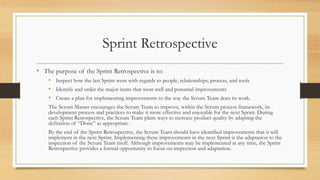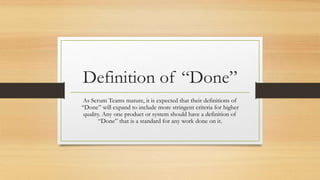Scrum Overview
- 1. SCRUM Overview By Maulik Shah
- 2. What is SCRUM • Scrum (n): A framework within which people can address complex adaptive problems, while productively and creatively delivering products of the highest possible value. • Scrum is not a process or a technique for building products; rather, it is a framework within which you can employ various processes and techniques. Scrum makes clear the relative efficacy of your product management and development practices so that you can improve. • https://www.youtube.com/watch?v=V5gnYy1sZL8
- 3. SCRUM Theory Scrum is founded on empirical process control theory, or empiricism. Empiricism asserts that knowledge comes from experience and making decisions based on what is known. Scrum employs an iterative, incremental approach to optimize predictability and control risk. Three pillars uphold every implementation of empirical process control: transparency, inspection, and adaptation. • Transparency • Significant aspects of the process must be visible to those responsible for the outcome. • Those performing the work and those accepting the work product must share a common definition of “Done”. • Inspection • Adaptation • Sprint Planning • Daily Scrum • Sprint Review • Sprint Retrospective
- 4. The Scrum Team Self-organizing and cross-functional. • The Product Owner • The Development Team • The Scrum Master Scrum Teams deliver products iteratively and incrementally, maximizing opportunities for feedback. Incremental deliveries of “Done” product ensure a potentially useful version of working product is always available.
- 5. The Product Owner The Product Owner is the sole person responsible for managing the Product Backlog. Product Backlog management includes: • Clearly expressing Product Backlog items • Ordering the items in the Product Backlog to best achieve goals and missions • Optimizing the value of the work the Development Team performs • Ensuring that the Product Backlog is visible, transparent, and clear to all, and shows what the Scrum Team will work on next • Ensuring the Development Team understands items in the Product Backlog to the level needed.
- 6. The Development Team They are self-organizing. No one (not even the Scrum Master) tells the Development Team how to turn Product Backlog into Increments of potentially releasable functionality • Development Teams are cross-functional, with all of the skills as a team necessary to create a product Increment • Scrum recognizes no titles for Development Team members other than Developer, regardless of the work being performed by the person; there are no exceptions to this rule • Scrum recognizes no sub-teams in the Development Team, regardless of particular domains that need to be addressed like testing or business analysis; there are no exceptions to this rule • Individual Development Team members may have specialized skills and areas of focus, but accountability belongs to the Development Team as a whole.
- 7. Scrum Master Service to the Development Team • The Scrum Master serves the Development Team in several ways, including: • Coaching the Development Team in self-organization and cross-functionality • Helping the Development Team to create high-value products • Removing impediments to the Development Team’s progress • Facilitating Scrum events as requested or needed • Coaching the Development Team in organizational environments in which Scrum is not yet fully adopted and understood.
- 8. Scrum Master Service to the Organization • The Scrum Master serves the organization in several ways, including: • Leading and coaching the organization in its Scrum adoption • Planning Scrum implementations within the organization • Helping employees and stakeholders understand and enact Scrum and empirical product development • Causing change that increases the productivity of the Scrum Team • Working with other Scrum Masters to increase the effectiveness of the application of Scrum in the organization.
- 9. Scrum Events-The Sprint • The heart of Scrum is a Sprint, a time-box of one month or less during which a “Done”, useable, and potentially releasable product Increment is created. Sprints best have consistent durations throughout a development effort. A new Sprint starts immediately after the conclusion of the previous Sprint. • Each Sprint may be considered a project with no more than a one-month horizon. Like projects, Sprints are used to accomplish something. Each Sprint has a definition of what is to be built, a design and flexible plan that will guide building it, the work, and the resultant product. • No changes are made that would endanger the Sprint Goal • Quality goals do not decrease • Scope may be clarified and re-negotiated between the Product Owner and Development Team as more is learned. • Cancelling Sprint
- 10. The Sprint • Sprint Planning • Sprint Goal • Daily Scrum • Sprint Review • Sprint Retrospective
- 11. Sprint Planning • Sprint Planning answers the following: • What can be delivered in the Increment resulting from the upcoming Sprint? • The Development Team works to forecast the functionality that will be developed during the Sprint. The Product Owner discusses the objective that the Sprint should achieve and the Product Backlog items that, if completed in the Sprint, would achieve the Sprint Goal. The entire Scrum Team collaborates on understanding the work of the Sprint • The input to this meeting is the Product Backlog, the latest product Increment, projected capacity of the Development Team during the Sprint, and past performance of the Development Team. • How will the work needed to deliver the Increment be achieved? • Having set the Sprint Goal and selected the Product Backlog items for the Sprint, the Development Team decides how it will build this functionality into a “Done” product Increment during the Sprint. The Product Backlog items selected for this Sprint plus the plan for delivering them is called the Sprint Backlog. Sprint Planning is time-boxed to a maximum of eight hours for a one-month Sprint. For shorter Sprints, the event is usually shorter. The Scrum Master ensures that the event takes place and that attendants understand its purpose. The Scrum Master teaches the Scrum Team to keep it within the time-box.
- 12. Daily SCRUM The Daily Scrum is a 15-minute time-boxed event for the Development Team to synchronize activities and create a plan for the next 24 hours. This is done by inspecting the work since the last Daily Scrum and forecasting the work that could be done before the next one. • What did I do yesterday that helped the Development Team meet the Sprint Goal? • What will I do today to help the Development Team meet the Sprint Goal? • Do I see any impediment that prevents me or the Development Team from meeting the Sprint Goal?
- 13. Sprint Review • Attendees include the Scrum Team and key stakeholders invited by the Product Owner • The Product Owner explains what Product Backlog items have been “Done” and what has not been “Done” • The Development Team discusses what went well during the Sprint, what problems it ran into, and how those problems were solved • The Development Team demonstrates the work that it has “Done” and answers questions about the Increment • The Product Owner discusses the Product Backlog as it stands. He or she projects likely completion dates based on progress to date (if needed) • The entire group collaborates on what to do next, so that the Sprint Review provides valuable input to subsequent Sprint Planning • Review of how the marketplace or potential use of the product might have changed what is the most valuable thing to do next • Review of the timeline, budget, potential capabilities, and marketplace for the next anticipated release of the product. The result of the Sprint Review is a revised Product Backlog that defines the probable Product Backlog items for the next Sprint. The Product Backlog may also be adjusted overall to meet new opportunities.
- 14. Sprint Retrospective • The purpose of the Sprint Retrospective is to: • Inspect how the last Sprint went with regards to people, relationships, process, and tools • Identify and order the major items that went well and potential improvements • Create a plan for implementing improvements to the way the Scrum Team does its work. The Scrum Master encourages the Scrum Team to improve, within the Scrum process framework, its development process and practices to make it more effective and enjoyable for the next Sprint. During each Sprint Retrospective, the Scrum Team plans ways to increase product quality by adapting the definition of “Done” as appropriate. By the end of the Sprint Retrospective, the Scrum Team should have identified improvements that it will implement in the next Sprint. Implementing these improvements in the next Sprint is the adaptation to the inspection of the Scrum Team itself. Although improvements may be implemented at any time, the Sprint Retrospective provides a formal opportunity to focus on inspection and adaptation.
- 15. Scrum Artifacts • Product Backlog • Sprint Backlog
- 16. Product Backlog • The Product Backlog is an ordered list of everything that might be needed in the product and is the single source of requirements for any changes to be made to the product. The Product Owner is responsible for the Product Backlog, including its content, availability, and ordering. • The Product Backlog lists all features, functions, requirements, enhancements, and fixes that constitute the changes to be made to the product in future releases. Product Backlog items have the attributes of a description, order, estimate and value. • Product Backlog refinement is the act of adding detail, estimates, and order to items in the Product Backlog. This is an ongoing process in which the Product Owner and the Development Team collaborate on the details of Product Backlog items.
- 17. Sprint Backlog • The Sprint Backlog is the set of Product Backlog items selected for the Sprint, plus a plan for delivering the product Increment and realizing the Sprint Goal. The Sprint Backlog is a forecast by the Development Team about what functionality will be in the next Increment and the work needed to deliver that functionality into a “Done” Increment. • The Sprint Backlog makes visibleall of the work that the Development Teamidentifies as necessary to meet the Sprint Goal.
- 18. Definition of “Done” As Scrum Teams mature, it is expected that their definitions of “Done” will expand to include more stringent criteria for higher quality. Any one product or system should have a definition of “Done” that is a standard for any work done on it.


















